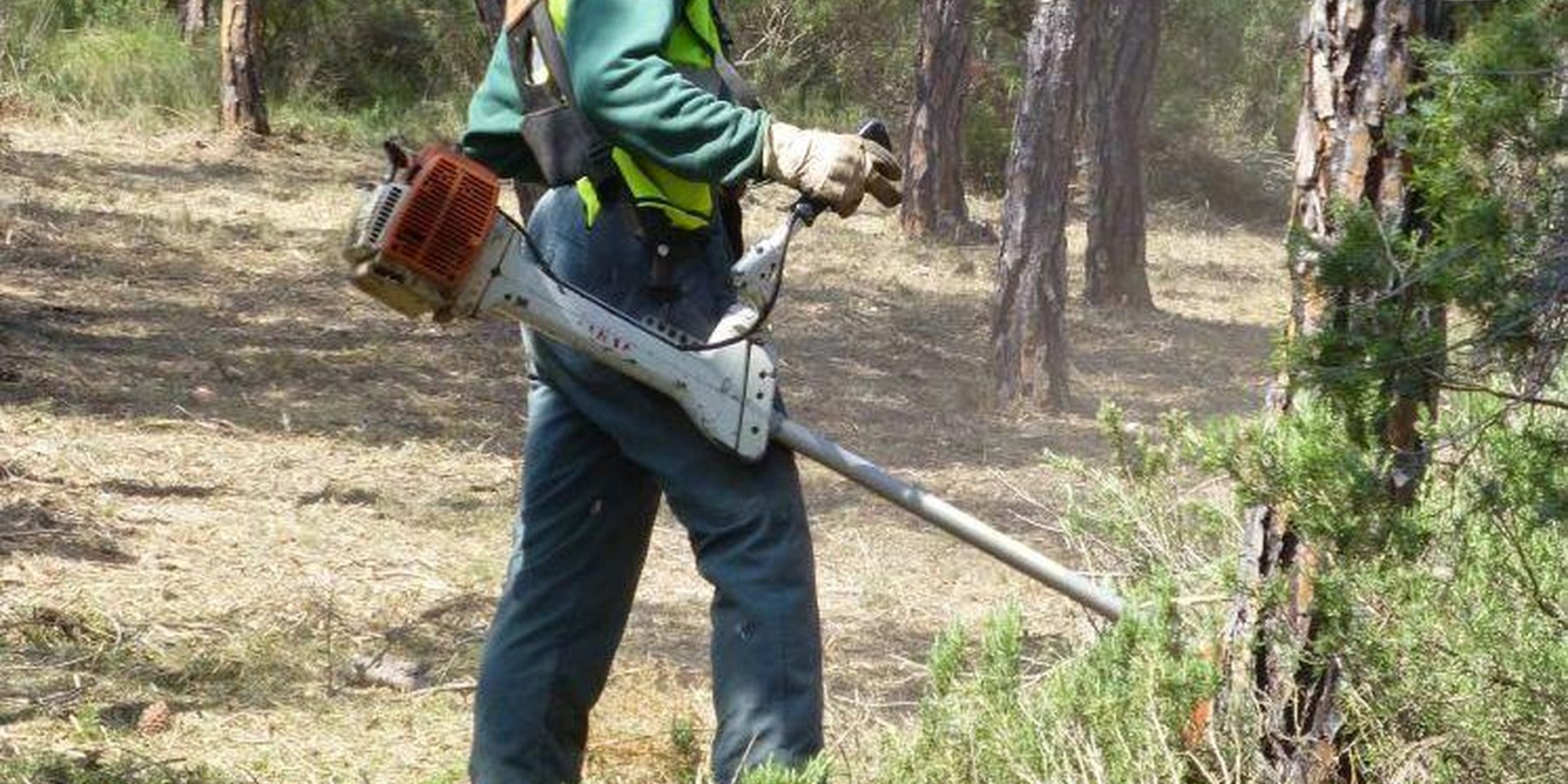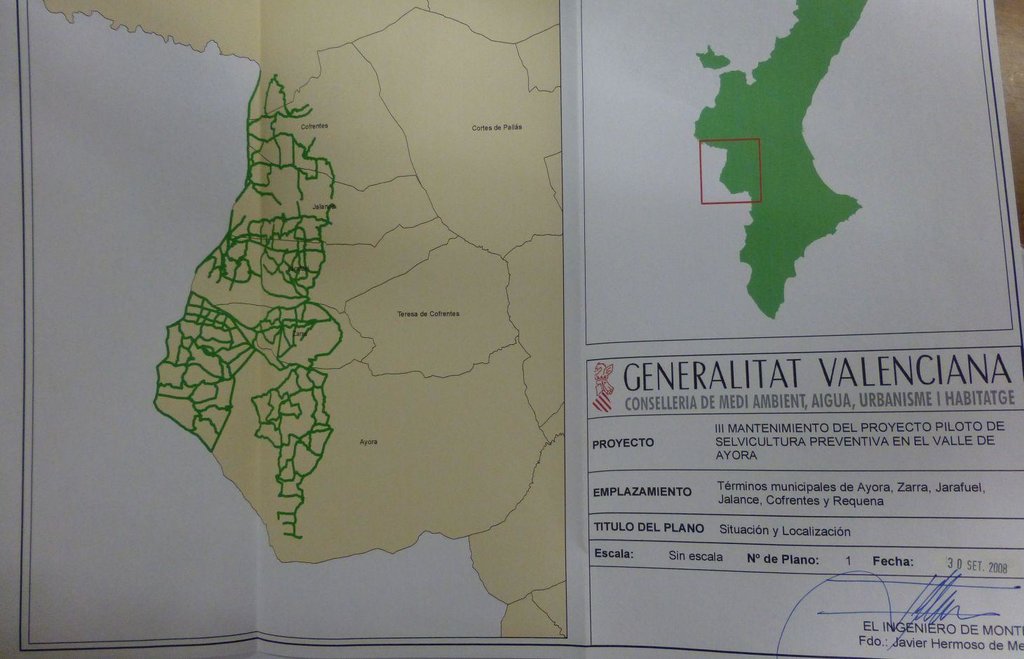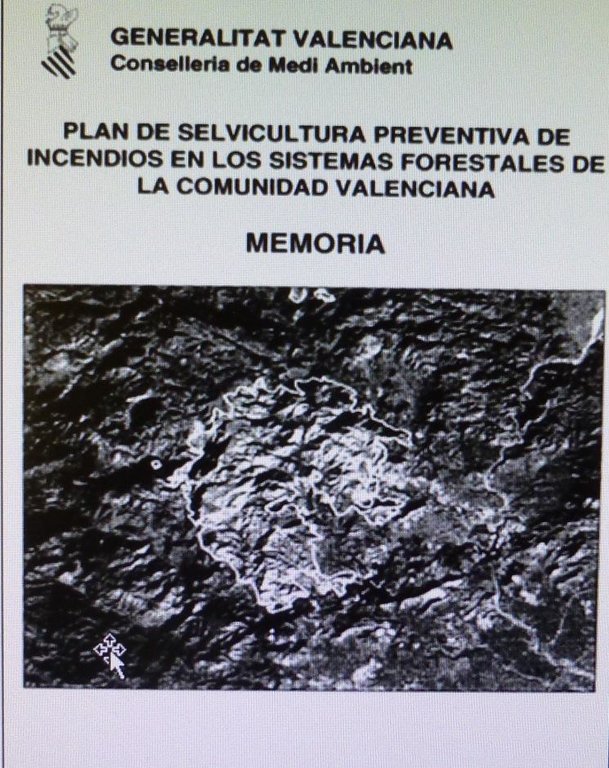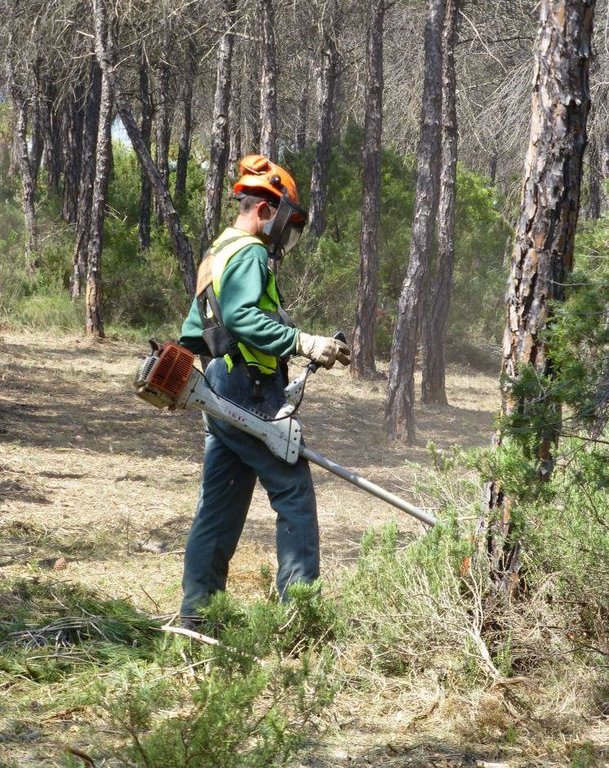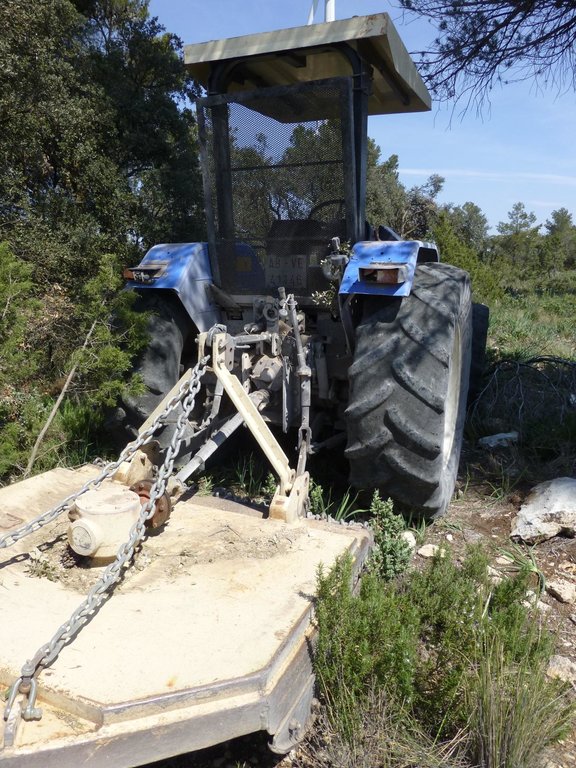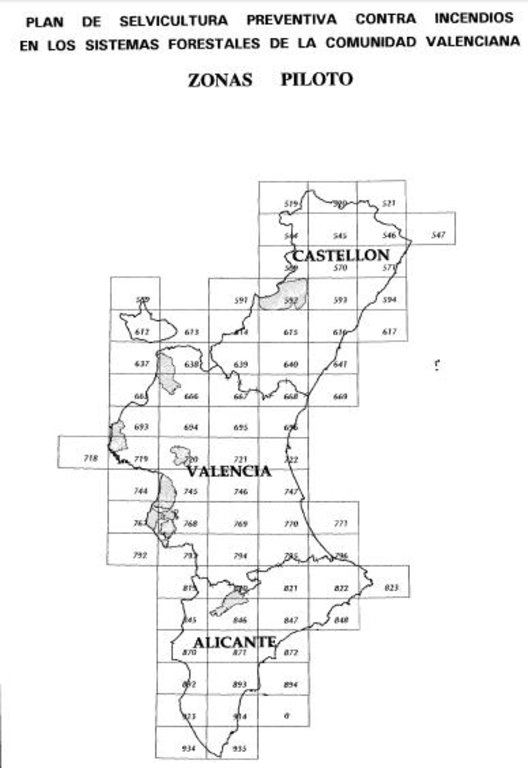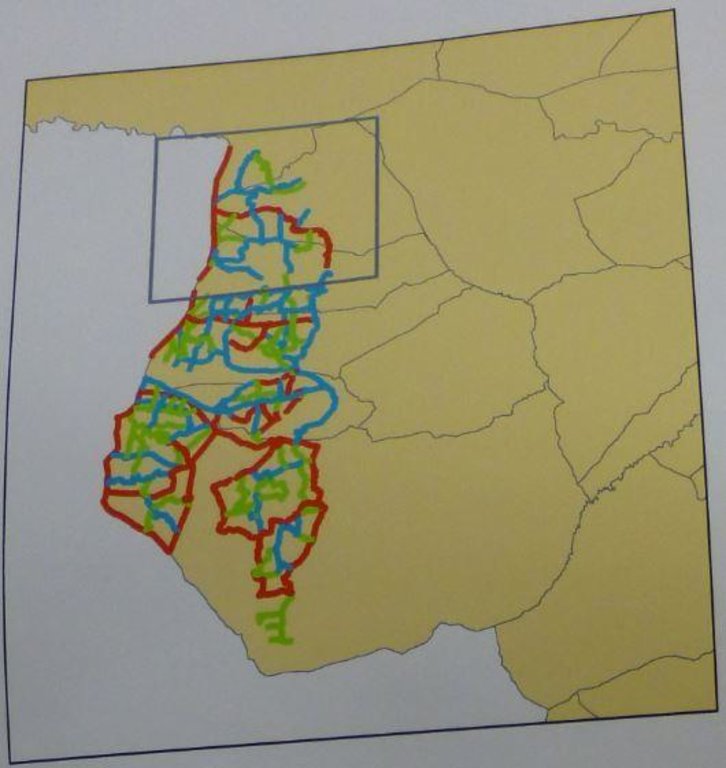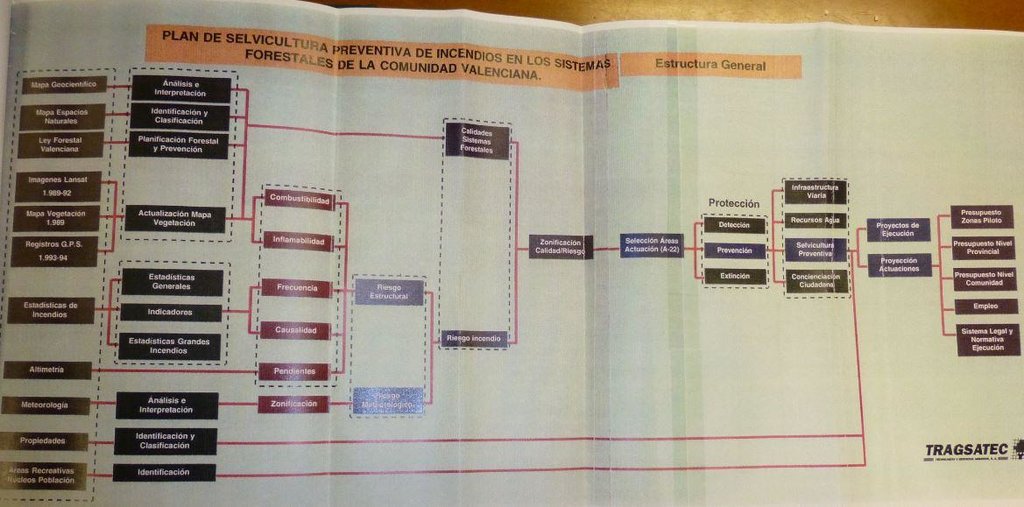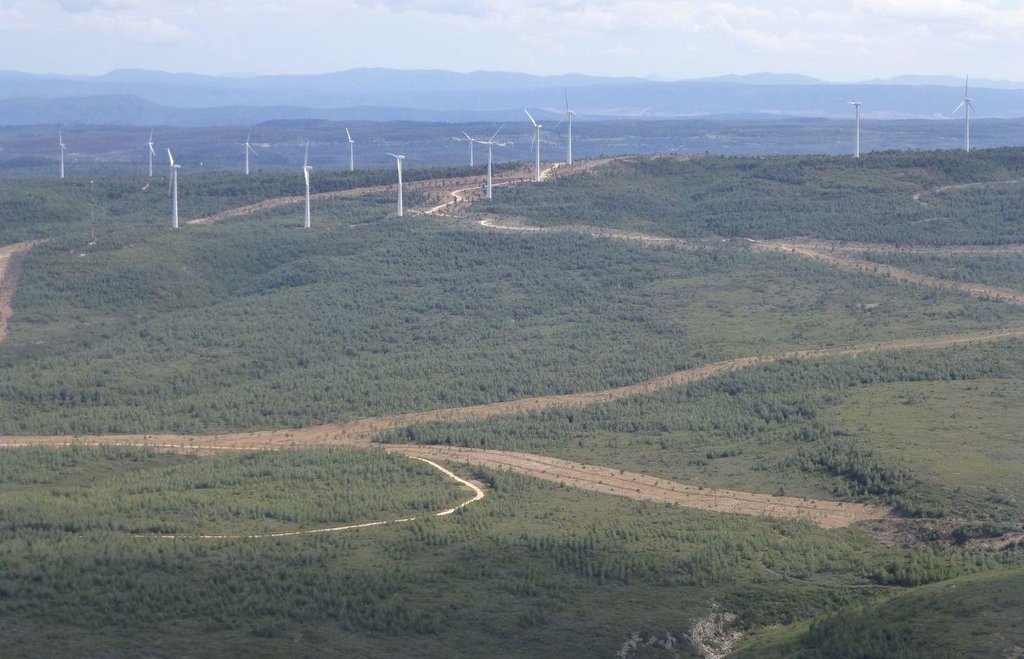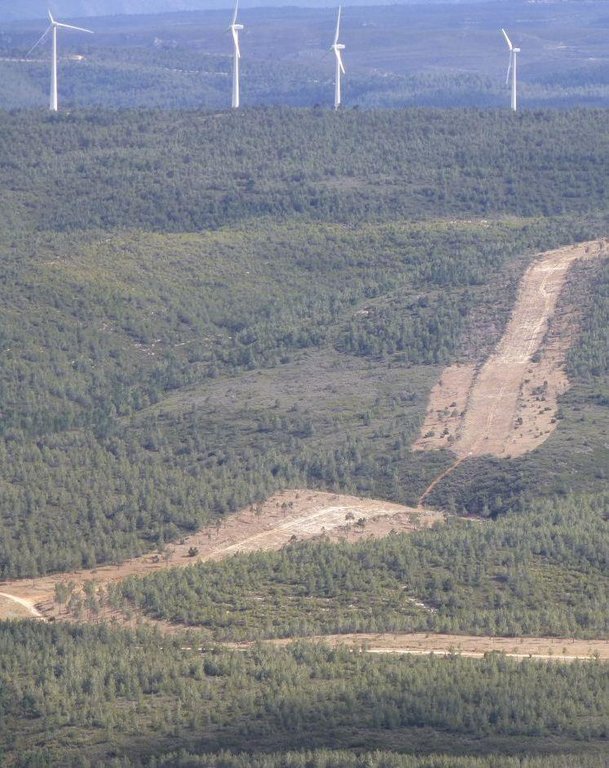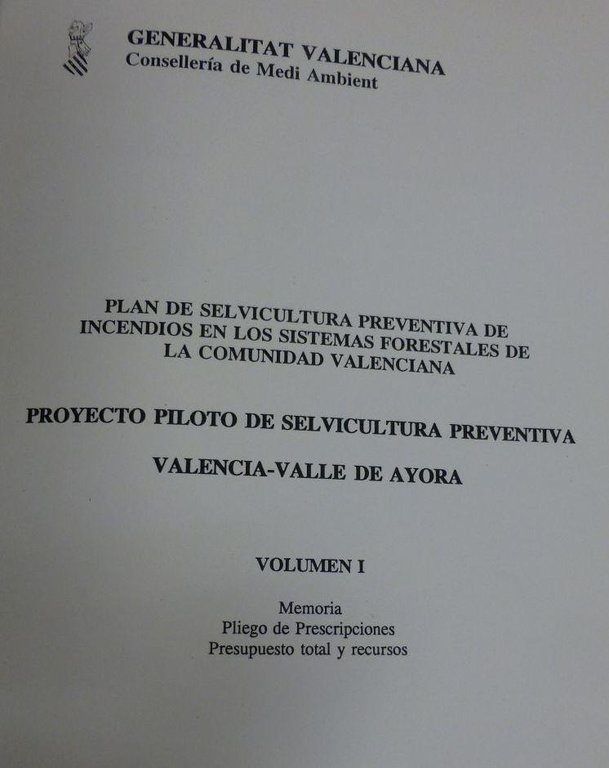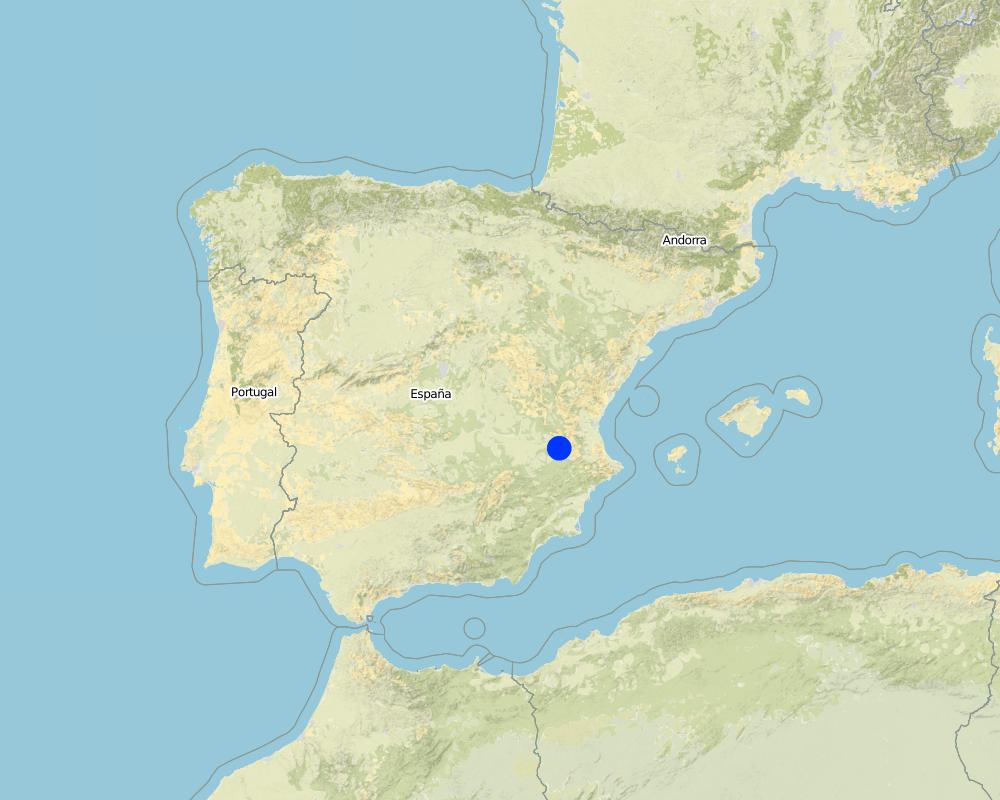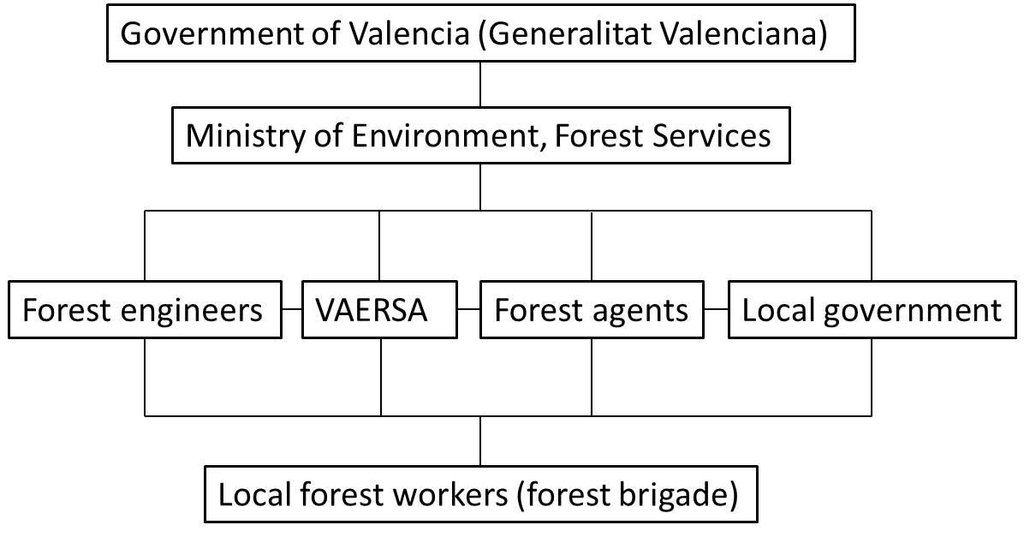Plan of preventive silviculture (PSP): implementation of firebreak network within a forest intervention area (ZAU) [Spain]
- Creation:
- Update:
- Compiler: Nina Lauterburg
- Editor: –
- Reviewer: David Streiff
Plan de selvicultura preventiva de incendios en los sistemas forestales de la Comunidad Valenciana (Spanish)
approaches_2590 - Spain
View sections
Expand all Collapse all1. General information
1.2 Contact details of resource persons and institutions involved in the assessment and documentation of the Approach
Name of project which facilitated the documentation/ evaluation of the Approach (if relevant)
Catastrophic shifts in drylands (EU-CASCADE)Name of the institution(s) which facilitated the documentation/ evaluation of the Approach (if relevant)
Centro de Estudios Ambientales del Mediterraneo (CEAM) - SpainName of the institution(s) which facilitated the documentation/ evaluation of the Approach (if relevant)
Generalitat Valenciana (GVA) - Spain1.3 Conditions regarding the use of data documented through WOCAT
When were the data compiled (in the field)?
06/05/2013
The compiler and key resource person(s) accept the conditions regarding the use of data documented through WOCAT:
Yes
1.4 Reference(s) to Questionnaire(s) on SLM Technologies
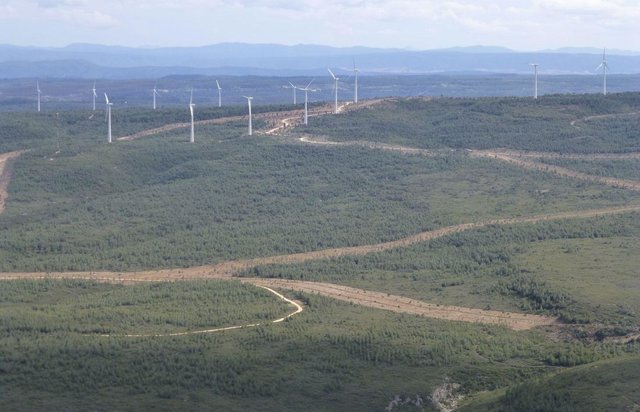
Cleared strip network for fire prevention (firebreaks) [Spain]
The basic principle of a firebreak network is to split continuous forest areas (where a lot of fuel is built up) into smaller patches separated by vegetation-free strips in order to prevent large forest fires.
- Compiler: Nina Lauterburg
2. Description of the SLM Approach
2.1 Short description of the Approach
Through the declaration of Ayora to a forest intervention area (ZAU) and the implementation of the pilot project of the PSP, a preventive silviculture was promoted through the establishment of a firebreak network.
2.2 Detailed description of the Approach
Detailed description of the Approach:
Aims / objectives: Forest fire is the main degradation driver in Ayora. In the article 24 of the forest law 3/1993 the declaration of special areas to forest intervention areas, so-called “Zonas de Actuación Urgente (ZAU)” through the regional government of Valencia is defined. Objectives are the protection against natural hazards and the promotion of conservation/restoration within a area which is degraded, affected by a forest fire (and natural regeneration is not probable), adverse climatic conditions, pests, severe ecological change, or fauna or flora of special value. If the use of the resources is not compatible with the conservation objectives within a ZAU, the administration has the right to enforce restrictions. The Ayora region was declared to a ZAU in 1997 due to its high risk of fires. In the “Plan de Selvicultura Preventiva de Incendios en los Sistemas Forestales (PSP)” (“plan of preventive silviculture to prevent forest fires”) which became operative in 1996 and whose main objective is the reduction of the fire risk, the ZAU was practically addressed for the first time in the establishment of a firebreak network (áreas cortafuegos). The PSP constitutes an important part of the “plan de protección contra incendios forestales” (“plan of protection against forest fires”) and has the following main objectives: The analysis/mapping of historic forest fires in Valencia (1984-1994) to support decision-making in silvicultural issues, the classification of the forest by quality and fire risk to establish local/regional plans to prevent fires (through silvicultural actions), selection of areas (province level) for the establishment of pilot projects (to apply silvicultural actions), decision on periodic investment and level of employment.
Methods: Within the PSP, 4 pilot projects were initiated in Los Serranos (17‘470 ha), Utiel-Requena (20’966 ha), Valle de Ayora-Cofrentes (33’851 ha) and Sierra de Mariola (11’574 ha) to promote a preventive silviculture which aims in modifying the amount of fuel in the forest through the establishment of a firebreak network and to limit the burnt area. The pilot areas were selected (in collaboration with the forest administration of Valencia) by the following criteria: representativity for the whole province, high value for the population, high potential risk of fire. In T_SPA009en the pilot project of Ayora-Cofrentes (Cofrentes, Jalance, Jarafuel, Zarra, Ayora) is described in detail and this approach focuses on the Ayora site as well. The firebreak network was established between 1998 and 2002, carried out by the company VAERSA and executed on both public and private land. Since the old firebreaks (established before the project) had a strong visual and ecological impact, the PSP designed a new type called “área cortafuego”. The continuous maintenance of the firebreaks is required which is also included in the pilot project. The total area protected by the firebreak network amounts to 33’851 ha while the management measures were executed on 1944,81 ha. The costs of the execution were 1312 Euro per ha, the maintenance 82.03 Euro per ha (all 2 years) and 31.37 Euro per ha (all 4 years).
Stages of implementation: After the establishment of the PSP (1996) and the declaration of Ayora to a ZAU (1997) the implementation of the pilot project was realized in the following phases: 1) splitting up of the territory based on the quality and the potential risk (using maps and aerial pictures), 2) field work (to examine the first draft of the firebreak network elaborated in the office), 3) office work (digitizing), 4) final map, 5) estimation of costs, 6) combination of firebreak plan with the cadastral land register.
Role of stakeholders: The PSP, the ZAU and the pilot projects were set up by the regional government of Valencia, in collaboration with the forest services. The PSP is put into operation each year by the forest services to plan the maintenance of the firebreak network. The effect on the local population is the creation of jobs in forest management.
2.3 Photos of the Approach
2.5 Country/ region/ locations where the Approach has been applied
Country:
Spain
Region/ State/ Province:
Spain, Valencia
Further specification of location:
Los Serranos, Utiel-Requena, Valle de Ayora-Cofrentes, Sierra de Mariola
Comments:
Within the plan of preventive silviculture, 4 different pilot projects were realized. One of them was established in Ayora with a total surface of 33‘851 ha. The total surface of all 4 pilot projects amounts to 83’861 ha.
Los Serranos: 39.821158°, -1.056726°
Utiel-Requena: 39.439729°, -1.054516°
Sierra de Mariola: 38.720744°, -0.574473°
Valle de Ayora-Cofrentes: 39.080541°, -1.180005°
Map
×2.6 Dates of initiation and termination of the Approach
Indicate year of initiation:
1996
2.7 Type of Approach
- project/ programme based
2.8 Main aims/ objectives of the Approach
The Approach focused mainly on SLM with other activities (analysis/mapping of historic fires to support decision-making in silvicultural issues, classification of forest systems by quality and fire risk to prioritise actions and establish local/regional plans)
Research on historic fires to support decision-making in silvicultural practices, fire risk reduction, reducing the burnt area through splitting up the forest, improvement of fire prevention and extinction measures (e.g. improvement of access for fire-fighting vehicles and protection of fire fighters), establish local/regional plans to prevent fires (through silvicultural actions), promote conservation of the forest on a large scale
The SLM Approach addressed the following problems: High amount of continuous fuel due to lack of management which increases the risk of vast and devastating fires, lack of fire prevention and extinction measures, ecological and visual impact of old firebreaks.
2.9 Conditions enabling or hindering implementation of the Technology/ Technologies applied under the Approach
availability/ access to financial resources and services
- hindering
There was a lack of money to implement silvicultural measures
Treatment through the SLM Approach: The pilot project of the PSP was fully financed by the government
institutional setting
- hindering
Laws on forest management existed already before the implementation of the PSP but the idea of establishing a firebreak network was not available
Treatment through the SLM Approach: With the pilot project of the PSP the firebreak network was carefully assessed and implemented
3. Participation and roles of stakeholders involved
3.1 Stakeholders involved in the Approach and their roles
- local land users/ local communities
Usually men are involved in the forest sector
In the execution and the maintenance of the firebreak network unemployed local people were/are included. But in the development of the PSP this was not the case.
Working in the execution and the maintenance of the firebreak networks
- SLM specialists/ agricultural advisers
Forest services, forest agents (working for the government of Valencia)
- local government
Probably the local governments helped in the implementation of the pilot projects, e.g. provision of maps.
- national government (planners, decision-makers)
Regional government of Valencia (Generalitat Valenciana), forest services, Forest engineers (working for the government of Valencia)
- Politicians in collaboration with SLM specialists
3.2 Involvement of local land users/ local communities in the different phases of the Approach
| Involvement of local land users/ local communities | Specify who was involved and describe activities | |
|---|---|---|
| initiation/ motivation | none | By government of Valencia |
| planning | none | By government of Valencia |
| implementation | external support | local people working in the execution and maintenance of the firebreak network, led by forest agents and forest engineers of the government of Valencia |
| monitoring/ evaluation | none | By government of Valencia |
| Research | none | By government of Valencia |
3.3 Flow chart (if available)
Description:
The PSP and the pilot projects were set up by the regional government of Valencia in collaboration with the forest services. Forest engineers and forest agents are employed at the forest services and helped to design the projects. VAERSA, a public company of the Generalitat Valenciana, executed the pilot projects and was supported by forest engineers, forest agents and the local governments. Local forest workers were contracted (by VAERSA) for execution and maintenance work and controlled by forest agents.
Author:
Nina Lauterburg
3.4 Decision-making on the selection of SLM Technology/ Technologies
Were decisions on the selection of the Technology(ies) made:
- Politicians in collaboration with SLM specialists
Explain:
The PSP, the ZAU and the pilot projects (firebreak network) were set up by the regional government of Valencia, in collaboration with the forest services (which also include SLM specialists)
Decisions on the method of implementing the SLM Technology were made by Politicians in collaboration with SLM specialists
4. Technical support, capacity building, and knowledge management
4.1 Capacity building/ training
Was training provided to land users/ other stakeholders?
Yes
Specify who was trained:
- land users
Form of training:
- on-the-job
Subjects covered:
Training of local people in the use of machinery in forest management (execution and maintenance of firebreaks)
4.2 Advisory service
Do land users have access to an advisory service?
Yes
Specify whether advisory service is provided:
- at permanent centres
Describe/ comments:
Advisory service is quite adequate to ensure the continuation of land conservation activities; The maintenance of the pilot projects is included in the PSP and is planned and executed by the government of Valencia. Already three maintenance projects followed after the execution of the pilot projects (2000-2004, 2004-2008, 2008-2012). Future funding of activities is not clear.
4.3 Institution strengthening (organizational development)
Have institutions been established or strengthened through the Approach?
- no
4.4 Monitoring and evaluation
Is monitoring and evaluation part of the Approach?
Yes
Comments:
technical aspects were regular monitored by project staff, government through observations; indicators: Observations of built-up of fuel to decide when and where maintenance is required
There were no changes in the Approach as a result of monitoring and evaluation: None
There were few changes in the Technology as a result of monitoring and evaluation: The technology is the same since the execution of the project but maintenance (e.g. clearing of firebreaks) is applied. Some more firebreaks were established where it was still required and not covered by the pilot project.
4.5 Research
Was research part of the Approach?
Yes
Specify topics:
- economics / marketing
- ecology
- technology
Give further details and indicate who did the research:
analysis/mapping of historic forest fires in Valencia (1984-1994) to support decision-making in silvicultural practices, classification of the forest by quality and fire risk, research on causes of forest fires
Research was carried out both on station and on-farm
5. Financing and external material support
5.1 Annual budget for the SLM component of the Approach
If precise annual budget is not known, indicate range:
- 100,000-1,000,000
Comments (e.g. main sources of funding/ major donors):
Approach costs were met by the following donors: government (government of Valencia ): 100.0%
5.2 Financial/ material support provided to land users
Did land users receive financial/ material support for implementing the Technology/ Technologies?
Yes
If yes, specify type(s) of support, conditions, and provider(s):
state (government of Valencia)
5.3 Subsidies for specific inputs (including labour)
- equipment
| Specify which inputs were subsidised | To which extent | Specify subsidies |
|---|---|---|
| machinery | fully financed | machinery for forest management |
- infrastructure
| Specify which inputs were subsidised | To which extent | Specify subsidies |
|---|---|---|
| roads | fully financed | |
If labour by land users was a substantial input, was it:
- paid in cash
Comments:
execution and maintenance of firebreak network (forest management)
5.4 Credit
Was credit provided under the Approach for SLM activities?
No
6. Impact analysis and concluding statements
6.1 Impacts of the Approach
Did the Approach help land users to implement and maintain SLM Technologies?
- No
- Yes, little
- Yes, moderately
- Yes, greatly
Improvement of fire extinction and prevention
Did the Approach empower socially and economically disadvantaged groups?
- No
- Yes, little
- Yes, moderately
- Yes, greatly
More jobs provided through this approach of forest management
Did other land users / projects adopt the Approach?
- No
- Yes, little
- Yes, moderately
- Yes, greatly
Within the PSP they carried out 4 pilot projects, and after the projects more firebreaks were established
Did the Approach lead to improved livelihoods / human well-being?
- No
- Yes, little
- Yes, moderately
- Yes, greatly
Reduction of the risk of fire and the loss of land through fires. Furthermore jobs were created by this project.
Did the Approach help to alleviate poverty?
- No
- Yes, little
- Yes, moderately
- Yes, greatly
More jobs provided through this approach of forest management
6.2 Main motivation of land users to implement SLM
6.3 Sustainability of Approach activities
Can the land users sustain what has been implemented through the Approach (without external support)?
- no
If no or uncertain, specify and comment:
The maintenance is expensive and has to be financed by the state. Furthermore, forest services need to provide technical assistance.
6.4 Strengths/ advantages of the Approach
| Strengths/ advantages/ opportunities in the compiler’s or other key resource person’s view |
|---|
| Before the implementation of the pilot projects of the PSP there was a lack of money and no institutional base. The pilot project allowed to establish a firebreak network (fully financed by the government of Valencia) (How to sustain/ enhance this strength: The government should sustain its investment in forest management. ) |
| The maintenance of the firebreak network is included in the PSP. (How to sustain/ enhance this strength: The government should sustain its investment in forest management.) |
| The firebreak network facilitates the access for fire fighters (and vehicles) and guarantees a higher security for people, thus increasing the possibility to control/slow down a fire. By arranging the territory in different parcels (firebreaks of first, second and third order) the spread of large forest fires is less probable (How to sustain/ enhance this strength: The maintenance of firebreaks is crucial. Furthermore, there must be a good coordination and organisation within the fire fighter staff in case of an emergency) |
| There are also firebreaks which were not established within the pilot project but due to a request of forest agents. The project was important to upscale this technology and to get people’s attention for the problem of forest fires. (How to sustain/ enhance this strength: Public awareness raising. ) |
|
There are both social and economic benefits for local people. The establishment and the maintenance of firebreaks provide jobs for rural people, which allows them to increase their livelihood conditions. People do not depend on unemployment payments and are therefore more accepted in society. (How to sustain/ enhance this strength: The government should sustain its investment in forest management and include the local population) |
6.5 Weaknesses/ disadvantages of the Approach and ways of overcoming them
| Weaknesses/ disadvantages/ risks in the compiler’s or other key resource person’s view | How can they be overcome? |
|---|---|
| Firebreaks do mainly work in fire extinction and less in fire prevention | Investigation of other management practices and approaches. An integrative way of forest management could be the clearing of fire-prone species and the planting of more fire-resistant species as suggested by CEAM. |
|
Little involvement of the local population. The projects were designed by the government without including local land users |
Include local land users in the planning of forest management. Work in a transdisciplinary way. |
| Land users cannot continue the SLM approach/ technology on their own. The maintenance is expensive and has to be financed by the state. Once the government will not continue paying the maintenance of the firebreaks the technology will probably not be managed anymore. Furthermore, forest services need to provide technical assistance | The government should sustain its investment in forest management. More trainings could be provided to local land users by the government of Valencia |
7. References and links
7.1 Methods/ sources of information
- field visits, field surveys
- interviews with SLM specialists/ experts
7.2 References to available publications
Title, author, year, ISBN:
Plan de selvicultura preventiva, laws, fire prevention plans, ...
Available from where? Costs?
Conselleria de infraestructura, territorio y medio ambiente de la Generalitat Valenciana www.cma.gva.es and http://www.112cv.com/prevencion/guatlla30/web-2520exportar/indice.aspx@nodo=206&idioma=c.htm
Links and modules
Expand all Collapse allLinks

Cleared strip network for fire prevention (firebreaks) [Spain]
The basic principle of a firebreak network is to split continuous forest areas (where a lot of fuel is built up) into smaller patches separated by vegetation-free strips in order to prevent large forest fires.
- Compiler: Nina Lauterburg
Modules
No modules


